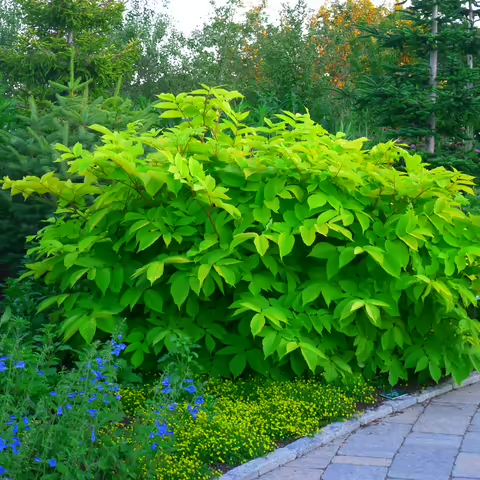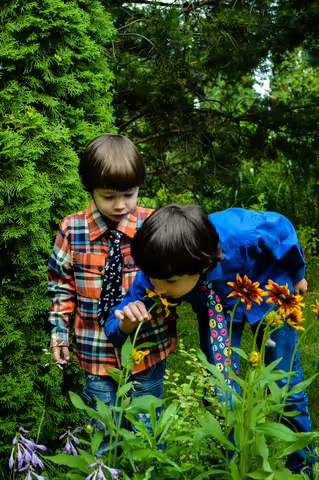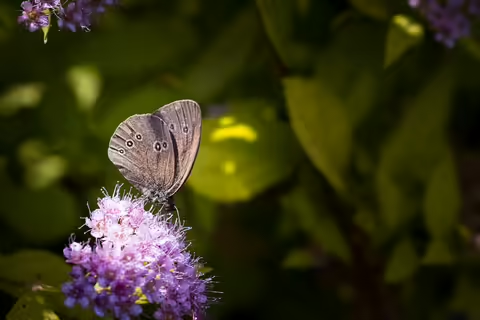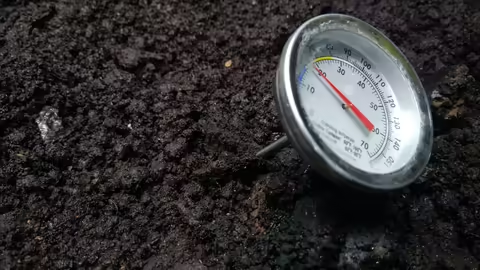Perennial Favorite Named Plant of the Year
By Martha Smith, Extension Educator – Horticulture
The Perennial Plant Association is proud to announce the 2020 Perennial Plant of the Year®: Aralia ‘Sun King’! This fabulous, high-impact perennial brings a bold pop of glowing color and texture to the shade or part-shade garden. Aralia ‘Sun King’ also won the International Hardy Plant Union Outstanding Plant Award in 2012.
Native to shady, forested areas in Japan, Sun King was discovered by plantsman Barry Yinger in a Japanese garden center. This perennial has become a beloved shade garden staple across the country. Bright yellow shoots emerge in spring, then grow upwards to 4-6’ tall and nearly as wide. The small, cream-colored umbels of flowers appear in late July through September, are attractive to bees, and are followed by tiny, dark (inedible) berries. This is a very well behaved plant with little reseeding or suckering.
Place Sun King where you want height. It is fast growing, filling a background space all season long. Hardy to USDA zones 3-9 (Northern Minnesota to Gulf of Mexico) it’s hard not to find a place in the garden for this gold-leaf beauty. To retain this color, place in partial shade; if in heavy shade, the color becomes more lime green. It will tolerate more sun as long as ample moisture is provided. During long periods of drought, Sun King will suffer if not kept watered. Being herbaceous, it will die back in the fall and re-emerge in the spring. It is best grown in well-drained soils and benefits from compost being incorporated. Sun King has no serious insect or disease problems, and deer don’t bother it.
Also called Udo, Japanese asparagus, Mountain asparagus, or Japanese spikenard, young shoots of this plant are considered a culinary delicacy in Japan, where they are cultivated in underground tunnels. The flavor is reported to taste asparagus-like, or lemony. Young shoots are blanched or pickled. White, fleshy roots are eaten as one would consume a parsnip.
Sun King is terrific in combination with hostas, ferns and past PPOY stars, such as Heuchera ‘Palace Purple’ (1991), Brunnnera acrophylla ‘Jack Frost’ (2012), and Polygonatum odoratum ‘Variegatum’ (2013). It’s a knockout when placed near Acer palmatum ‘Bloodgood,’ or other maroon-leaf plants. And, don’t forget containers—Sun King is bold and beautiful in a big pot!
This low-maintenance perennial benefits from a pinching, or slight cutback in May to encourage branching. It truly meets the criteria set by the Perennial Plant Association to be awarded the Perennial Plant of the Year®. The PPOY program began in 1990 to showcase a perennial that is a standout among its competitors. Perennials chosen are suitable for a wide range of growing climates, require low maintenance, have multiple-season interest, and are relatively pest and disease-free.
Why You Should Think About Sequence of Bloom
By Andrew Holsinger, Extension Educator - Horticulture
Sequence of bloom describe when a plant is expected to bloom. Planning for the sequence of bloom is a great way to keep your garden attractive all year round. Flowering is only one aspect of a garden, but the amount of bloom can boost your garden’s appeal substantially. While the influences of nature vary from year to year, the sequence of bloom remains the same.
Encouraging successive blooms throughout the year has many benefits beyond visual appeal. Continual bloom adds a source of food for pollinators and provides a level of interest each season. It increases the spread of fruit availability when thinking about edible landscaping. The sequence of bloom is also a great marketing strategy. A forecast of what’s in bloom draws interest and a garden feels more dynamic when there is constant, evolving change.
Plant selections based on sequence of bloom can be maximized for impact. Distribute blooming plants uniformly around the garden to elevate the level of bloom overall. Keep in mind, proper site selection is critical in providing the best environment for successful flowering.
Planning a garden with sequence of bloom in mind doesn’t have to be complicated. Focusing on the timing of what’s in bloom at an approximate time of the year can help you develop a strategy for planting. But there are other strategies to consider when selecting new plants for your garden.
- Compile a list of what you already have blooming.
- Evaluate your hardiness zone for what will thrive.
- Reference each plant’s approximate time of bloom.
- Match layers of bloom with the landscapes’ visual height.
- Develop a color scheme that enhances your selections.
- Think about purpose and how your design choices are influenced by it. For example, do you want plants that will provide a pollinator food source?
- Consider how long your plant selection blooms. Period of bloom can also influence your choices.
- Select new plants that will complement the existing elements and timing of your garden.
Sample Gantt Chart for managing your bloom sequence
If you are a visual thinker, there are a few ways to organize the sequence of bloom for different plant combinations on paper. A Gantt chart helps create a view of scheduled tasks or events over a designated period of time. This type of chart would be great for visualizing the blooming sequence. Color-coding can also present an easy, quick reference for what plants might work to optimize your space.
The next time you visit a garden, pay close attention to what’s in bloom and how it contributes to the overall impact of the garden. Considering the sequence of blooms in your planting strategy will help you to create a more robust garden full of visual beauty throughout the year.
Designing a Sensory Garden
by Brittany Haag, Extension Educator - Horticulture
Sensory gardens are areas designed to stimulate one or more of the five senses: sight, smell, sound, taste, and touch. While often geared toward young children, sensory gardens can be enjoyed by all ages. They can also be therapeutic for individuals with developmental or physical disabilities, sensory processing disorders, or cognitive challenges. While exploring any garden, you are already connecting with some of your senses, but a sensory garden has a more mindful approach by including and arranging specific plants to engage the senses.
Sight
Contrasting color, texture, light, shadow and form in the garden can all stimulate our sense of sight. Warm colors, like red, orange and yellow, are energizing, while cool colors, like blue, purple and white, are relaxing. The plants selected should be both stimulating and calming. Bright mixes of garden zinnias (Zinnia elegans) or giant yellow sunflowers (Helianthus annuus) towering above the garden make for an invigorating pop of color, and both will attract beautiful butterflies to the garden.
Smell
Smell is often the strongest human sense, with the potential to bring back specific memories and experiences to individuals. Some plants release scent naturally without the need for touch (roses), while others do not release a scent until they are rubbed or crushed (geranium). Catmint (Neptea mussini), a hardy perennial that produces pale purple flowers from May to September, releases a light lavender-like scent when the leaves are rubbed.
Sound
Some sounds in the garden occur naturally—wind blowing through the plants, or leaves crunching beneath our feet. Wind chimes and water fountains can add a calming sound, as well. Bird feeders and baths can attract our feathered friends to visit the garden to play their song. Ornamental grasses, like switchgrass (Panicum virgatum), rustle in the wind. Dried seed pods on false blue indigo (Baptisia autralis) can make natural maracas as the seed rattles against the hard pod.
Taste
A variety of fruits, vegetables and herbs can be added to a sensory garden to explore tastes. Edible flowers, including nasturtium and pansy, also make tasty additions. Be sure to clearly identify which plants in the garden are edible.
Touch
A variety of textures to explore, including rough, smooth, fuzzy and even sticky, should be offered through plant bark, foliage, flowers, seeds, and fruits. Tough plants that can withstand frequent handling should be selected. Lambs ear (Stachys byzantine) is a favorite fuzzy-leaf plant to include.
Just like with any garden, select plants that are hardy to your area and of various color, height, textures, and bloom times. To ensure safety in the garden, plants should be non-toxic and pesticides should not be applied. A sensory garden is a great place for anyone to explore their senses and to learn about nature and plants.
Wildlife-Friendly Gardens
by Nicole Flowers-Kimmerle, Extension Educator - Horticulture
Do you enjoy watching bees buzzing around your flowers, butterflies resting in the sun, or a fat toad sitting in a shady spot? Making your garden wildlife-friendly starts with knowing what will attract birds, insects, and animals to your yard. Wildlife needs water, a food source, shelter, and space. Small changes in your garden habitat can make a big difference to the wildlife you wish to attract.
One way to attract wildlife to your garden is to add a water source, like a birdbath. To maintain a healthy environment for your wildlife, be sure to clean your birdbath two to three times per week. It’s important to thoroughly rinse away all cleaning products from the birdbath before refilling it with clean water and allowing animals to use it again. Birdbaths are not the only option, though. A water source can be as simple as a rock with a depression that holds water.
Another thing to consider for a wildlife-friendly garden is a food source. When it is time for fall clean up, consider leaving seed heads on perennial plants, which can be a food source for birds. Leaf litter and hollow stems can provide overwintering sites for many beneficial insects and pollinators. Plants that flower early offer a food source for those insects as they become active in the spring. Make sure that your garden includes a variety of plants, so that there are blooms from early spring to late fall. Increase the variety of butterflies by providing food for their larvae. Plants from the carrot and aster families are great options. Plant extra dill or parsley, and you may see more swallowtail butterflies in your garden.
It’s important to remember that as you provide an attractive habitat for wildlife, pests may also find your garden. Not to fear, though! Insect predators and parasites, attracted to the variety you’ve created, will move in and help control those pests. Insect-eating birds will find their way to your garden if their preferred food becomes more abundant. Some organic farms even include birds as part of their pest management plan. Keep in mind that there will be a lag time between the pests showing up and the beneficial creatures doing their job to decrease the population. Just be patient and trust that they will take care of those pests for you in due time.
Shelter is the third important component of a wildlife-friendly garden. Provide shrubs and trees that vary in height for housing all types of animals. Consider creating a toad house by turning over a terra cotta pot and propping up one side to create an entrance. Toads are another creature that will help control insect pests.
Finally, sit back and enjoy the wildlife that is visiting your garden. Recording your observations in a nature journal is a fun way to spend time in your garden with the added bonus of helping you track how your garden and its wildlife inhabitants change from year to year.
Soil Temperatures for Spring Planting
by Chris Enroth, Extension Educator - Horticulture
Most gardeners understand that seeds germinate in warm soils. Sow your tomato seeds too early in the spring when the ground is still cold and you may get little to no germination. My favorite saying is, “When you can sit comfortably on the ground bare-bottomed, it’s time to plant your garden.”
Luckily, there are more reliable ways to monitor your soil temperatures. Soil thermometers are a simple and cheap tool for keeping track of the soil temperatures in your yard and garden.
Knowing your soil temperature is important because it tells you when you can put seeds in the ground. Seeds have a germination window of soil temperatures. Yes, you can germinate Romaine lettuce at 35 degrees Fahrenheit, but this will lead to slow plant development. Romaine’s optimum soil temperature for germination is usually around 70 degrees.
Keep in mind that when growing outdoors, those warmer soil temperatures come with hotter weather, which could be stressful to vegetables. Waiting to plant your greens until your soil is 70 degrees, may be too late in the growing season. Seed packets, catalogs, or the supplier’s website will tell what you need to know about when to plant flowers and vegetables.
Influences On Soil Temperature
The first major influence on your soil temperature is its exposure to the sun. Photons of sunlight travel the vast distance of space into our atmosphere, striking the surface of the Earth. Much of that light energy is transferred to heat energy and radiates back out toward space or is absorbed by the soil. The surface of the soil heats up at the beginning of the day and cools off at night. Lower layers of soil warm by convection from the top surface. This means they warm up slower, but hold their heat longer. When sowing seeds, monitor the soil temperature at whatever depth you will be planting the seeds.
Soil type and moisture also play a role in soil temperature. Sandy soil is very well-drained. This allows the surface to heat and cool rapidly. Think about walking on a hot sand beach. Bury your toes a little in the sand and you get some relief from the hot surface. Clay soils can hold a lot of water, which means it takes more solar energy to warm them up; once warm, though, clay soil tends to hold that heat longer. Many gardeners with heavy clay soils find it takes much longer in the spring for their ground to warm up, which may prolong seed germination.
Manipulating Soil Temperature
Gardeners anxious for spring may use techniques to increase their soil temperature and get a jump start on planting.
- Site your garden in a south-facing exposure. Exposure to sunlight has the biggest influence on soil temperatures.
- Use sheets of plastic or fabric mulches to trap heat at the soil surface. Clear plastic will allow sunlight in but trap the heat. Keep in mind, though, this may also hasten weed growth. When using fabric or row covers, remove them during sunny days and replace them at night.
- Construct raised beds, which warm up quicker in the spring. This can be a good tool for gardeners with heavy clay or contaminated soils.
- Lightly till to break up the soil surface and encourage drier soils that heat up faster. Be mindful that dry soils will also cool quickly and that tilling cold, wet soils can create compaction and clods.
- Create a completely artificial germination chamber by starting plants indoors using heat mats and lighting. Hold them indoors until the soil and air temperatures are conducive to their growth.
Protecting Tender Plants from Spring Frost
By Austin Little, Extension Educator – Horticulture
The long winters of the Midwest can give gardeners false hope that spring has arrived, depending on Punxsutawney Phil’s weather forecast. In early spring, many cool-season annuals and perennials are breaking dormancy and starting to bloom well before the threat of frost has passed. Rather than relying on a rodent’s prediction, there are several easy practices that protect vulnerable plants from unpredictable spring frost.
To protect tender buds from a light spring freeze, one of the best defenses is to cover the plants. The covering acts as an insulation layer that helps to hold warm air radiating from the ground and adds protection from cold, dehydrating winds. There are many types of coverings for plants. For smaller annuals and perennial plants, a simple cardboard box, sack, or pot could do the trick. The French have used cloches (small glass coverings) for frost protection since the 1600s. Cloches can be thought of as temporary, miniature greenhouses.
For small shrubs, a large bucket or blanket can be used. While it may not be pretty, it gets the job done. I have seen my dad use sheets to save his prized azaleas on several occasions. Small trees, such as fruit trees, and larger shrubs may pose a bit more of a challenge. One option is to use large, fleecy, white row cover fabrics that act as a great insulator, but will need to be anchored with something heavy, or pinned to the ground.
Another surprising, yet effective measure against spring frost is water. This may seem counterproductive, but due to the unique chemical properties of H2O, as it freezes on the surface of foliage, it actually releases heat as the water changes from a liquid to a solid. Spraying larger shrubs and small trees with a coating of water before a freeze can help save flowering buds. On a smaller scale, watering the root zones of smaller plants can also be effective. Plant cells that are well hydrated are able to buffer temperature changes more effectively. The same is true for an evenly wetted soil compared to a dry soil. One caution is to make sure the temperatures will be above freezing the next day to avoid more damage than would otherwise occur.
With these practices, it may be possible to save many tender buds from occasional spring frosts and get the most out of those much-appreciated, early spring blooms.
Download This Issue of the Newsletter
Download, save, and share the Volume 15: Spring 2020 issue of the newsletter.
© Copyright 2020 by the Board of Trustees of the University of Illinois. For information on duplicating or linking to this material, please contact extension@illinois.edu. Commercial uses are prohibited.
University of Illinois • U.S. Department of Agriculture • Local Extension Councils Cooperating. Issued in furtherance of Cooperative Extension Work, Acts of May 8 and June 30, 1914, in cooperation with U.S. Department of Agriculture. Shelly Nickols-Richardson, Director. University of Illinois Extension provides equal opportunities in programs and employment.




